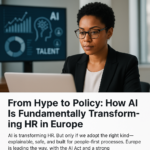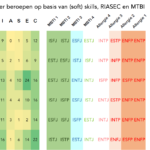During my vacation, I daydreamed about hybrid employment contracts and a basic income for everyone 😍—allowing you to engage in unlimited forms of commitments to deliver meaningful work. Enabling you to combine a lifetime of working, playing, and learning. To eliminate bullshit jobs and unlock the potential of all workers in society. To combat inequality and poverty and to drive ecological transitions. I’ve written it all down in this blog.
Explanatory Text for Publication on LinkedIn
If it were up to me, we’d completely abolish the differences between permanent and flexible work. It’s so irrelevant. One moment I need more stability, the next I crave dynamism. Workers are so scarce nowadays that more people are realizing that job security exists anyway, and you don’t need a permanent job for that. You want to be able to play; embrace more innovation or just enjoy some steadiness. The same goes for employers. One moment they want more flexibility, the next they want to rely on a fixed group of employees. Current contract forms don’t fit the reality where employers and employees want to adjust the desired flexibility at any moment. And discussions about contract forms distract from the essence: is everyone doing the right, meaningful work?
Redistributing Social Securities with Hybrid Contract Forms
Despite intensive efforts by policymakers to combat flexibility, the annual growth of flex workers is unstoppable. Let’s cease that fight, embrace the opportunities of flexibility, and seek solutions for its downsides. This means fundamentally revising how we organize our social security so that costs, contributions, and access to work are fairly distributed among all workers. Yes, thinking in the direction of a basic income, thereby eliminating much income stress and bureaucracy.
Incidentally, I’ve been advocating these ideas for years (see the video below from 2018), but they are more relevant than ever: the ‘polder’ truly needs vision now.
Keynote Speaker at the HR Horizon Conference
To make real progress in our socio-economic issues, we need to eliminate the differences between workers and non-workers. What does it matter how much percentage you contribute where at any given moment and whether you do or do not fit into a certain box? Flexible contract forms should be activated and deactivated with a click, so that when choosing a gig, I don’t have to think about whether I’m employed for it, am a freelancer, outsource myself, or do volunteer work. Let me perform 1 to 100 gigs and roles simultaneously; and don’t bother me with the systems. Isn’t everyone above, say, 8 years old a potential asset to our society?
Considering today’s reality, a few fundamental misconceptions underlie the current labor market system. Take the idea that an employer must take care of their employees. That’s noble and a step forward since slavery, but such a vertical relationship is increasingly outdated. In practice, you’re a work contractor one moment, a work provider the next. Work is often distributed horizontally. You handle that task, then I’ll take on this one.
Playing with Hierarchy at All Levels of Society
To work pleasantly and effectively, you need to be able to do what you’re good at, feel like doing, or learn the most from. So, breaking free from your fixed set of tasks. One moment I shift something to you, the next you shift something to me. You can’t call it delegating—with the fading of hierarchical structures in organizations, it’s more effective collaboration. More and more companies are becoming network organizations, where responsibilities are assigned lower in the organization. Change comes as much bottom-up as top-down (and effective change from all directions).
For an increasing number of societal issues, we also need to let go of the idea that you always ‘take care of’ people top-down. It no longer works and leads to gaps and distrust in the government. Sometimes it does, of course, but certainly not always. Therefore, we need to start ‘playing with hierarchy.’ Ten years ago, I worked with a group of innovators on implementing these concepts within the social domain. The animation about it is still worthwhile.
Video: Playing with Hierarchy
Working with Numerous Commitments Simultaneously
My connections with organizations are no longer as they were in the last century: only one employer at a time and only a few throughout your career. A large part of the population now works for multiple employers simultaneously, combines paid and volunteer work, or has multiple clients. Emerging gig platforms play an important role in facilitating multiple types of work models simultaneously. I’m connected with countless organizations—some intensively for daily collaboration, others I support or help from time to time with distant involvement. Does your organization also have such a flexible layer? And does your educational institution offer a lifelong connection to facilitate lifelong learning, regardless of the career switches I make?
Those who still believe in labor market tightness are stuck in thinking that people must be trained and choose a job in linear career paths. More and more ‘hierarchical refugees’ (thanks for the term, Martijn Aslander) no longer want to work that way. If they don’t feel autonomy, control, and meaning in their work, they quit. And rightly so. The intensive human husbandry (thanks, Jaap Peters) is over. In the past, you had participation ladders and co-determination; nowadays, organizations are more like swarms, where everyone has equal say and is guided by expertise and talent, rather than hierarchical power.
Effectively Deploying Unused Personnel
If I’ve learned anything from the corona crisis, it’s that reality looks different from the systemic world. Hundreds of thousands of volunteers who wanted to support healthcare couldn’t be deployed. Thousands of homebound call center employees were not allowed to make calls for the municipal health services. Hundreds of companies that wanted to organize a personnel exchange faced policy barriers. Despite numerous possibilities to use idle personnel effectively, truly flexible labor markets turned out to be an illusion. Of course, there were successes, such as hospitals that quickly redeployed scaled-down departments to corona units using platform technologies. But witnessing so much untapped potential that was exposed yet not meaningfully utilized woke me up. This must and can change!
That’s why I’m so happy to live in this time of incredible possibilities. Apps that predict your skills, suggest surprising career steps; platforms that match you to suitable work; and AI that arranges your contract forms. Increasing openness to diversity and inclusion. Now, we just need to adjust the systems, structures, and thinking to the new reality. I’m eager to roll up my sleeves for that because if we can continuously place everyone in the right job, so much potential will be unleashed. If we harness all that energy to eliminate bullshit jobs and actively contribute to societal and ecological transitions, we’re heading toward a wonderful future!




Leave a Reply